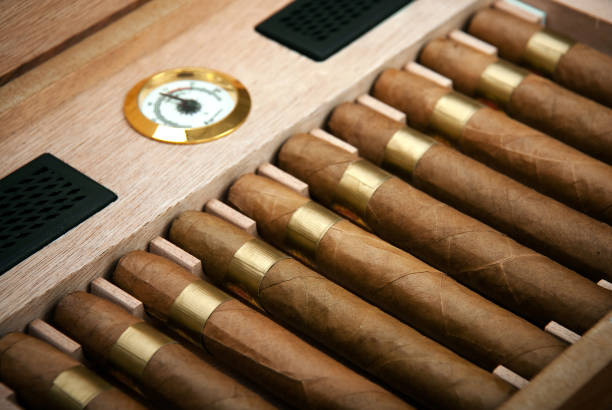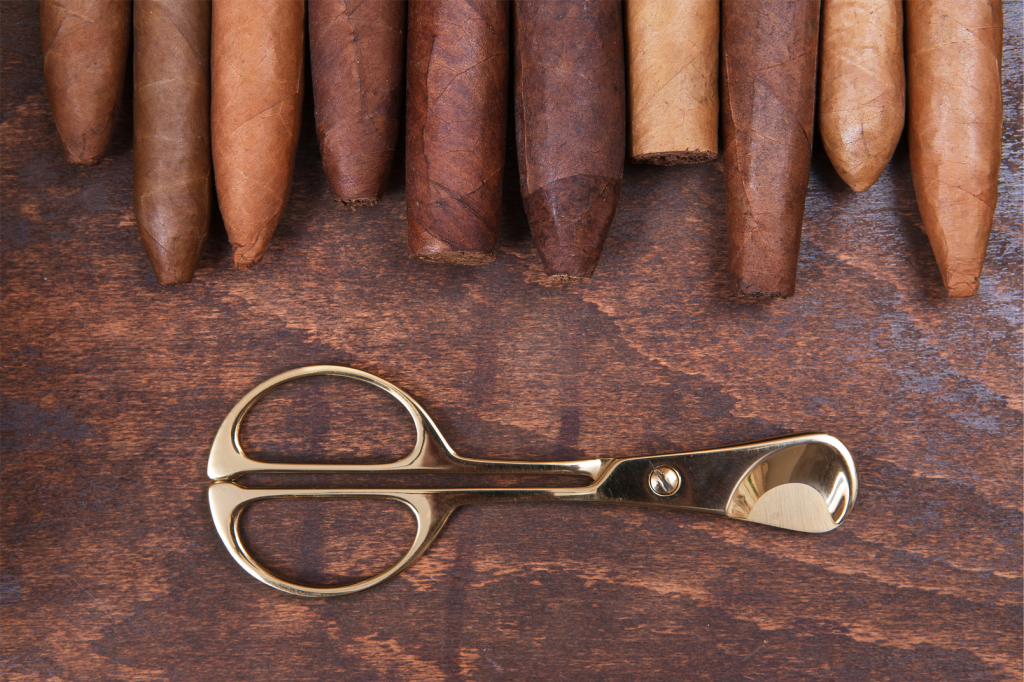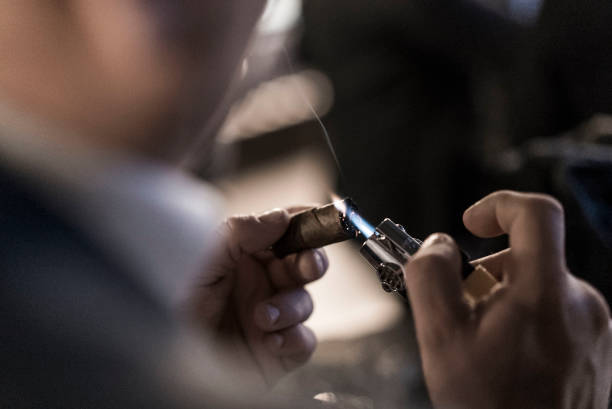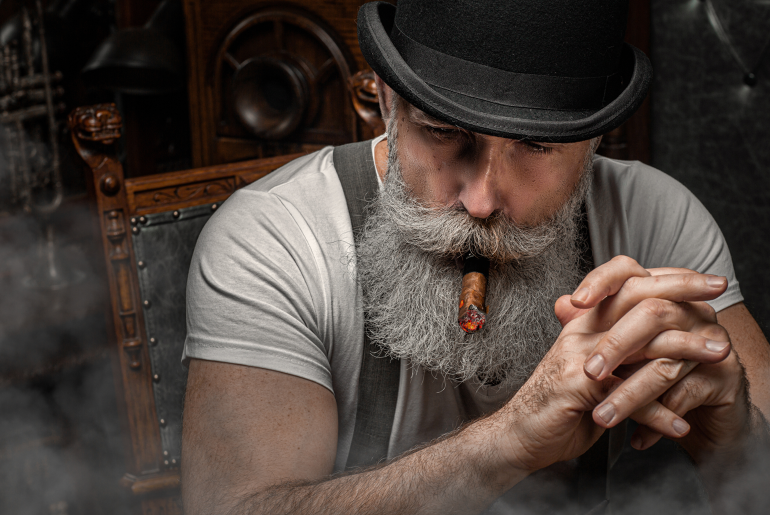Preparing a cigar for a delightful smoking session is more than just cutting and lighting it up. It involves essential steps that contribute to overall enjoyment and satisfaction. Whether you are a novice or a seasoned enthusiast, mastering the art of cigar preparation is crucial. In this comprehensive guide, we will walk you through the process, from adequately storing your cigars to inspecting and cutting the cigar. Following these steps ensures a smooth and flavorful smoking experience every time, so let’s dive in and discover how to prepare your cigars like a true connoisseur.
Proper Storage and Humidity

The first step to preparing a cigar for smoking is storage. An adequately stored premium cigar will provide you with smoking pleasure galore. But keeping your cigars in an old tin or some random wooden box won’t do them good either—cigars require proper storage to maintain their freshness and flavors.
Investing in a humidor is highly recommended for any cigar enthusiast. A humidor is a specially designed box that regulates temperature and humidity levels, creating an ideal environment for cigar storage. Here are a few key points to consider:
Humidity Control
Invest in a humidor or other suitable storage options to maintain the desired humidity level, usually around 65–70% relative humidity, to preserve the cigars’ moisture and prevent them from drying out or becoming overly moist.
Use a hygrometer to monitor and adjust the humidity inside the humidor accordingly.
Temperature Control
Keep the humidor in a cool and stable environment, away from direct sunlight and extreme temperature changes. A temperature of around 70°F (21°C) is optimal for preserving cigar quality.
Categorize and Organize
Arrange your cigars neatly in the humidor, grouping them based on their strength or flavor profiles. This will prevent cross-contamination and allow you to effortlessly select the perfect cigar for any occasion. It is also a time of reflection and meditation as I sit and contemplate life’s mysteries.
After all that hard work, it is time to select one, light it up, and celebrate a job well done.
Examine the Cigar‘s Craftmanship

When you’re ready to select a cigar, pay attention to its appearance and construction.
Wrapper Quality
Inspect the wrapper for visible flaws, such as tears, holes, or significant veins. A high-quality wrapper should be smooth, consistent, and tightly wrapped around the cigar. Avoid cigars with damaged or discolored wrappers, as they may affect the smoking experience.
Construction
Gently squeeze the cigar to assess its firmness. A well-constructed cigar will feel evenly packed with no soft or hard spots. The cap should be clean and straight, showing attention to detail in its manufacturing.
A properly constructed cigar ensures a more enjoyable and consistent smoking experience.
Aroma
You can give the cigar a gentle sniff to detect its smell. While the wrapper contributes to the overall fragrance, the scent of the filler tobacco can provide clues about the flavors you might experience during the smoking process. Look for cigars with enticing aromas that align with your flavor preferences.
The (First and Only) Cut Is the Most Important

Choosing the proper cut for your cigar is crucial, as it determines the draw and overall smoking experience. Imagine going to a tailor to have a bespoke suit made. You’ve selected the best cashmere cloth you can afford. The tailor has all your measurements. Your tailor proceeds but doesn’t pay attention when cutting the parts. Your suit’s fit is crooked, the pants’ one leg is shorter than the other… What a nightmare! You paid the guy to deliver a quality product!
The same goes for your cigar—you’ve invested a small fortune in a quality cigar because you’re celebrating a milestone. You’ve cut your cigar too deep, and it unravels… Measure twice and make one decisive cut with a clean cigar cutter. Ideally, your cut should be about 3 mm (1/8 of an inch) from the tip of the cigar’s head; anything more, and you won’t have the most remarkable smoking experience.

There are different cutting techniques available, each with its advantages. Let’s explore some options below.
Straight Cut
This classic method involves cutting the cap straight across. You can use a guillotine cutter, a cigar scissor, or a cigar punch to achieve this. A straight cut offers a clean and unrestricted draw, allowing the flavors to come through effortlessly. It’s suitable for most cigars, especially those with a smaller ring gauge.
V-Cut or Cat’s Eye
A V-shaped cut creates a notch in the cap, exposing the filler tobacco. You can achieve this using a specialized V-cutter. This cut provides a slightly different draw, concentrating the smoke towards the palate’s center. It’s ideal for cigars with larger ring gauges, enhancing the flavors and richness.
Punch Cut
A punch cut involves using a circular blade to create a small hole in the cap. You can use a cigar punch tool for this. This method provides a controlled draw, allowing the flavors to develop gradually. It’s excellent for cigars with a tighter draw or delicate wrappers
Piercing
A method favored by smokers who want to control the draw and avoid overpowering puffs. By making a hole in the cap, the smoke circulates smoothly, giving you a more controlled experience with less smoke. Plus, the cigar drill, also known as a perforator, is compact and easy to carry around in your pocket without drawing attention.
One great advantage of piercing is that it keeps the head of the cigar intact, preventing any damage to the delicate wrapper while you smoke. Some seasoned smokers even make two holes on larger cigars to ensure an even draw. However, be aware that this can lead to the accumulation of tar in the head, resulting in a bitter taste.
It’s important to note that not all cigars are suitable for piercing. Torpedos and figurados, for example, have a unique shape that doesn’t lend itself well to piercing. Additionally, a pierced cigar may require more frequent relighting, so be prepared to keep that flame handy to maintain a consistent burn.
It’s worth noting that while some people prefer biting off the cap, it is generally not recommended. Biting can lead to an uneven cut, damaging the wrapper and affecting the overall smoking experience. Using a proper cutting tool ensures a clean and precise cut, preserving the integrity of the cigar.
Remember, whether you choose to pierce, cut, or use another method, the goal is to enhance your smoking experience and enjoy the flavors to the fullest. Experiment with different techniques and find what works best for you. Here’s a video demonstration of the different types of cuts.
Toast the Foot for a Perfect Start

When it comes to cigars, patience is a virtue. Properly toasting the foot of your cigar sets the stage for a pleasurable and consistent burn throughout the entire smoke. It may seem like a small detail, but it can make a world of difference in your overall cigar experience.
Toasting the cigar foot serves a crucial purpose: it ensures that all the cigar components ignite simultaneously. You see, a cigar is not just a bundle of tobacco leaves rolled together; it’s a carefully crafted blend of filler, binder, and wrapper. Each component contributes its unique flavors and characteristics.
By toasting the foot, you awaken these elements and allow them to harmonize, creating a symphony of flavors. Never place the cigar’s foot directly into the lighter’s flame directly.
One common misconception is that only the filler needs to be lit. However, that’s far from the truth. The flavorful wrapper leaf, often overlooked, plays a significant role in the overall taste profile of the cigar. Only the filler tobacco would ignite without proper toasting, resulting in an imbalanced and uneven burn. By toasting the foot, you ensure that the wrapper leaf also ignites, enriching the flavor experience.
Lighting Technique

Now, let’s talk about technique. To properly toast your cigar, hold it at a 45-degree angle, allowing easy access to the foot. You can choose to use a long wooden match or a trusty butane lighter—whatever suits your preference.
Rotate the cigar gently while gradually bringing the flame closer to the foot. The idea is to evenly warm the tobacco and ignite it without allowing the flame to touch the cigar directly. The heat radiating from the flame is usually sufficient to toast and light your cigar. Generally speaking, a torch lighter is the perfect tool for the job.
It’s essential to be mindful during this process. Take your time and enjoy the moment. Feel the anticipation build as you see the foot gradually light up. You may notice the aroma intensifying, signaling the start of a delightful smoking experience. Avoid rushing or charring the foot excessively, as it may result in a harsh and unpleasant taste.
Once your cigar is evenly toasted, take a moment to appreciate the craftsmanship and the care that went into its creation. You’re now ready to take that first puff and embark on a journey of flavors and relaxation. Remember to pace yourself and enjoy the nuances as the cigar develops.
Toasting your cigar is not just a practical step; it’s a ritual that adds depth and meaning to your smoking experience. So, the next time you reach for a cigar, take a moment to toast it appropriately, allowing the flavors to bloom and the enjoyment to unfold. Cheers to a well-toasted and memorable smoke!
Further Tips to Enhance Your Cigar Smoking Experience

Here’s some more tips to help you prepare a cigar like a true cigar aficionado:
Initial Puffs and Checking the Draw
After your cigar is fully lit, take a few initial puffs to establish a proper burn. Puff gently, allowing the cigar to heat up and draw air through the tobacco. Avoid inhaling at this point, as cigars are meant to be savored in the mouth, not inhaled into the lungs.
Checking the draw is a crucial step to ensure your cigar’s performance. The draw refers to how easily air passes through the cigar, affecting how smoothly it burns. A tight draw can make the cigar difficult to smoke, while a loose draw can lead to an overheating cigar and less satisfying flavors.
Puff Gently at First
During the initial puffs, a few, gentle puffs are eesential. This slow and deliberate approach allows the heat to evenly distribute throughout the cigar, creating an even burn. Puffing too forcefully at the beginning can result in overheating, causing the flavors to become harsh and bitter.
By puffing gently, you allow the tobacco to gradually warm up and release its nuanced flavors. The initial puffs set the tone for the entire smoking experience, so taking your time and being patient pays off in the long run.
Conclusion
Preparing a cigar for an enjoyable smoking experience requires attention to detail and an understanding of the process. By inspecting, cutting, storing, toasting, and lighting your cigars correctly, you can enhance the flavors, draw, and overall satisfaction. Remember to take your time, savor the experience, and explore the diverse range of cigars available. Each cigar offers a unique combination of flavors, aromas, and strengths. With the proper preparation, you can truly immerse yourself in the world of cigars and indulge in a time-honored tradition that brings relaxation and enjoyment to any occasion. So, gather your favorite cigars, follow these steps, and elevate your cigar-smoking experience to new heights. Cheers!

